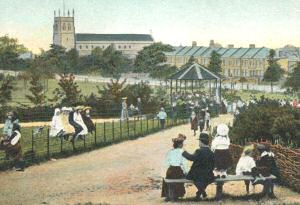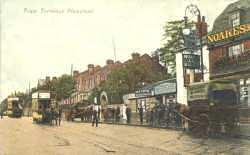Contents
- Before Development: A Place of Little Consequence
- Burrage Town: The First Estate in Plumstead
- Herbert Estate: Development on the High Slopes of Shooters Hill
- Plumstead Park Estate and the Saving of Plumstead Common
- The Plumstead Common Riots, 1876
- Bostall Estate, Abbey Wood
- Suburban Necessities: Churches, Schools, Shops and Public Houses
Plumstead: A 19th suburb of Woolwich's industrial and military might
by Barbara Ludlow
The Plumstead Common Riots, 1876
The people of Plumstead strongly opposed the ambitions of Queens College stating that they had the right to graze cattle, geese and other livestock, the right to cut turf and to dig for sand and gravel on the Common.
Also they claimed the right to use the open space for sports and other pastimes. Eventually hundreds of people joined in demonstrations for the purpose, digging gravel and sand for their own use.
These actions attracted the attention of John De Morgan, a leading light of the Commons Protection League. On 1st July 1876 he spoke to a crowd of about 1,000 local people in front of the Old Mill beerhouse (the windmill had been converted into a beerhouse in 1853). De Morgan then took the crowd around the common with the intention of removing recently erected fences.
The authorities, afraid that the revolution had started, arrested him and other demonstrators charging them with riotous assembly, and disturbing the peace. John De Morgan went to prison for seventeen days. The riots concentrated the minds of politicians and, in 1878, the Plumstead Common Act ensured that about one hundred acres of land remained as public open space forever. The Act was passed just in time as some roads had been built across the Common effectively dividing it into the two portions that can be seen today.
Between 1870 and the early 1900s roads to the north of Plumstead Common Road were made between the Herbert Estate and the Slade. The ancient Plum Lane soon ran between roads in which superior Victorian and Edwardian houses approached the heights of Shooters Hill.
William Dawson, a successful brick and tile maker, lived in a large house called “The Links” in parkland behind his works, which bordered Plumstead Common Road. He had gradually sold off other land for housing, and had become a developer himself. At the beginning of the 20th century he closed his works between Palmerston and Macoma Roads in order that they could be completed. His house was demolished and, in 1905, the Royal Arsenal Co-operative Society opened “The Links,” a terrace of elegantly designed shops. This provided a much needed and smart shopping area for the new up-market estate.
In 1872 the Woolwich Union Workhouse was opened between Plumstead High Street and Tewson Road. No longer would the poor of Plumstead have to go to Lewisham Workhouse. They now had a grim, gothic Union Workhouse of their own in the middle of their community. After its closure in 1929 the workhouse became St. Nicholas Hospital. Now even the hospital has gone – the site has been redeveloped for housing.
In 1889 the County of London was created and the people of Plumstead, once villagers, became Londoners. All this with the stroke of a pen!
In 1900 the Metropolitan Borough of Woolwich came into being and the ancient parish system of government and the later Board of Works disappeared. Woolwich, Plumstead, and the still rural Eltham were joined together under one administration. Plumstead entered the 20th Century with a population of 68,327, a massive increase from the 1,166 villagers resident at the beginning of the previous century.
The benefit to Plumstead of being administered by the new local authorities: Woolwich Borough Council, and the London County Council soon became apparent. Within a few years a range of well-designed modern amenities became available to Plumstead people.
Woolwich Council promoted the use of electricity in the home and workplace by building a combined refuse incinerator and electricity generating station in White Hart Road, Plumstead. This very advanced concept became operational in 1903.
One year later Plumstead Library was opened in the High Street, and, in 1907 Plumstead Baths and Washhouses were built on an adjacent site. In 1919 Plumstead Museum was opened on the first floor of Plumstead Library. The library and the museum still flourish but the baths have been demolished to make way for a small housing development.
In 1900 the London County Council Tramways Act (Electric) was passed in order to run a network of electric trams throughout the county of London. The new local electric tram service, which ran from Woolwich along Plumstead Road and High Street to Abbey Wood, was a boon to people who lived and worked locally.

